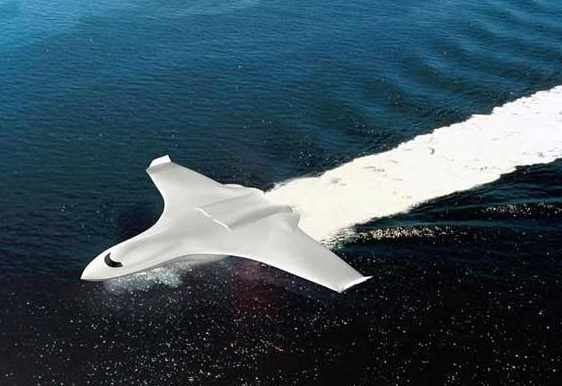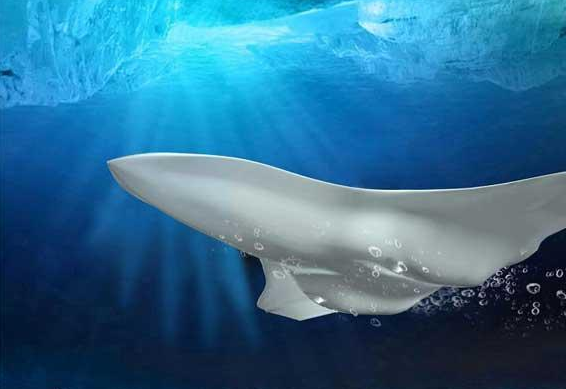|
|
Flight design: an omnibus vehicle for undersea citiesIssuing time:2014-01-03 21:32 With the rapid development of science and technology and the increasingly crowded living space for human beings, the undersea city predicted by science fiction scientists may become a reality, and the creation of an all-purpose aircraft to communicate between the land and the future undersea city has its motivation. Here, according to the current development of some cutting-edge technologies, the design boldly looks forward to the future, and proposes a design scheme for an all-habitat aircraft based on the future undersea city. The omni-habitat aircraft can start from the shipping port of the undersea city, go through the stages of underwater submersible, surfacing, taking off on the surface, flying in the air, and finally landing at the ground airport, so as to realize one-stop transportation and greatly reduce the transportation time.
Flying over the water
Underwater stealth Pneumatic layout and flight control: This design USES the flying wing type layout, in order to get the cleanest possible appearance to reduce the aircraft in the air and underwater resistance. The wing adopts shape memory material and deformation structure, which can be adjusted to the corresponding state to adapt to different environments of air, water and underwater operation. The intake of the aspirated pulsed detonation engine is located at the back of the fuselage, which prevents water spray from being sucked into the engine. The fuselage adopts the hull v-shaped bottom, and sets two protruding pontoons in the rear of the fuselage, which can greatly reduce the water resistance when the plane takes off from the surface of the water. And a water inlet is set on each buoy, which is used for pump jet propulsion. In order to reduce drag, no conventional control surfaces are used. The roll control of the aircraft is realized by the integral deformation of the wing tip. The pitch and yaw are controlled by the fluid vector control of the tail nozzle which is highly coordinated with the pulse detonation engine. The entire wing curve can be adjusted for various operating conditions. All controls are coordinated by a highly intelligent fly-by-wire system for optimal performance. Power plant: This design plans to use the inspiratory pulse detonation engine and the seawater magnetofluid engine to realize the air and underwater propulsion respectively. The sea pump jet propulsion system is used as the auxiliary of the pulse detonation engine in the sea surface dispatching. Existing turbine engines, with their complex structures and numerous components, are vulnerable to corrosion if they are not sealed underwater, and severe temperature changes pose great challenges to such engines. On the contrary, the characteristics of the inspiratory pulse detonation engine are suitable for this harsh service environment: first, its structure is quite simple, even reduced to a cavity, which can be used as the magnetic flow wall of the magnetofluid engine under water; The pulse knock engine starts quickly and can start from the static state to realize the power conversion quickly. In addition, as the combustion process belongs to constant volume combustion, it has the advantages of high heat cycle efficiency, low oil consumption rate and low exhaust pollution. Internal layout: The rear of the vehicle is equipped with an oxygen storage tank, which provides oxygen to the fuel cell in the case of hypoxia under water, as well as air pressure for the buoyancy control system. The passenger cabin is located in the middle of the fuselage. The flying wing layout makes the passenger cabin quite spacious and brings great convenience to the internal layout. In addition, due to the aircraft to underwater navigation, its structure needs to withstand greater water pressure, in addition to the use of high-performance materials, but also should try to maintain the integrity of the aircraft structure. To this end, the passenger cabin of this design USES the electronic vision system to replace the traditional porthole. Flight state and state transition strategy: 1. Air flight status and ground take-off and landing: the working status is equivalent to that of normal aircraft. 2. Surface take-off and landing: during the surface take-off and landing phase, the buoyancy software of the wing tip is opened (as shown in the figure) to increase the stability and maneuverability of the aircraft. The main power in this stage is the working thrust of the pulse detonation engine, and the sea pump jet propulsion system is only used as an auxiliary. 3. Underwater running state: the buoyancy control system controls the aircraft to enter the water. Under the simultaneous action of structural deformation and material shape memory, the wings contract in a large area, reducing the contact area between the aircraft and the water and reducing the resistance. At the same time adjust the wing curvature to adapt to the flow of water. After the aircraft enters the water, the magnetofluid engine starts to work. The sea water enters from the engine inlet and flows out from the tail nozzle after the electromagnetic field accelerates, generating thrust. Key technologies that could lead to the birth of an all-terrain aircraft: 1. Pulse knock engine technology; 2. Deformed structure and shape memory material; 3. High-performance materials (high strength, anti-corrosion, anti-creep, sealing material); 4. Fluid vector control technology of pulse knock engine; 5. Seawater magnetofluid propulsion and related high-temperature superconductor technology; 6. Fuel cell technology; 7. Flight control and buoyancy control; 8. Navigation and life support systems. Outlook: This design has not been separated from the wing lift principle, we can fully assume that the future does not depend on the wing lift principle (such as momentum theorem) can be widely used, aerodynamic shape is no longer the main constraint factor of aircraft design, structure, loading and other design has been greatly liberated, then human will enter a new era of flight. |


